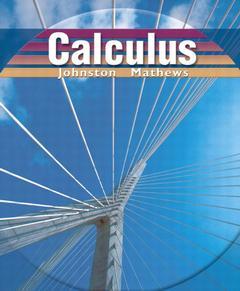Calculus
Langue : Anglais
Auteurs : JOHNSTON Elgin, MATHEWS Jerry

Calculus is a text intended to help students in the engineering, mathematical, and physical sciences learn calculus more effectively, not only as a foundation for such subsequent courses as differential equations, linear algebra, or numerical analysis, but also as preparation for courses in chemistry, physics, or engineering.
(Each Chapter concludes with "Review of Key Concepts," "Chapter Review Exercises," and "Student Projects.")
1. Rates of Change, Limits, and the Derivative.
Functions.
Compositions of Functions.
Slope as a Rate of Change.
Calculating Rates of Change.
Limits.
More Work with Limits.
The Derivative.
2. Finding the Derivative.
Compositions of Functions.
Slope as a Rate of Change.
Calculating Rates of Change.
Limits.
More Work with Limits.
The Derivative.
2. Finding the Derivative.
Derivatives of Polynomials.
Derivatives of Products and Quotients.
Differentiating Compositions.
Implicit Differentiation.
Trigonometric Functions.
Exponential Functions.
Logarithms.
Inverse Functions.
Inverse Trigonometric Functions.
Modeling: Translating the World into Mathematics.
3. Motion, Vectors, and Parametric Equations.
Derivatives of Products and Quotients.
Differentiating Compositions.
Implicit Differentiation.
Trigonometric Functions.
Exponential Functions.
Logarithms.
Inverse Functions.
Inverse Trigonometric Functions.
Modeling: Translating the World into Mathematics.
3. Motion, Vectors, and Parametric Equations.
Motion Along a Line.
Vectors.
Parametric Equations.
Velocity and Tangent Vectors.
Dot Product.
Newtons Laws.
4. Applications of the Derivative.
Vectors.
Parametric Equations.
Velocity and Tangent Vectors.
Dot Product.
Newtons Laws.
4. Applications of the Derivative.
The Tangent Line Approximation.
Newtons Method.
Increasing/Decreasing Functions, Concavity.
Horizontal and Vertical Asymptotes.
Tools for Optimization.
Modeling Optimization Problems.
Related Rates.
Indeterminate Forms and LH pitals Rules.
Eulers Method.
5. The Integral.
Newtons Method.
Increasing/Decreasing Functions, Concavity.
Horizontal and Vertical Asymptotes.
Tools for Optimization.
Modeling Optimization Problems.
Related Rates.
Indeterminate Forms and LH pitals Rules.
Eulers Method.
5. The Integral.
Summation Notation.
The Definite Integral.
The Fundamental Theorem of Calculus.
Indefinite Integrals.
Integration by Substitution.
Areas between Curves.
Integration by Parts.
Integration by Partial Fractions.
Solving Simple Differential Equations.
Numerical Integration.
6. Applications of the Integral.
The Definite Integral.
The Fundamental Theorem of Calculus.
Indefinite Integrals.
Integration by Substitution.
Areas between Curves.
Integration by Parts.
Integration by Partial Fractions.
Solving Simple Differential Equations.
Numerical Integration.
6. Applications of the Integral.
Volumes by Cross-Section.
Volumes by Shells.
Polar Coordinates and Parametric Equations.
Arc Length and Unit Tangent.
Areas of Regions Described by Polar Equations.
Work.
Center of Mass.
Curvature, Acceleration, and Keplers Second Law.
Improper Integrals.
7. Infinite Series, Sequences, and Approximations.
Volumes by Shells.
Polar Coordinates and Parametric Equations.
Arc Length and Unit Tangent.
Areas of Regions Described by Polar Equations.
Work.
Center of Mass.
Curvature, Acceleration, and Keplers Second Law.
Improper Integrals.
7. Infinite Series, Sequences, and Approximations.
Approximation Using Series.
Taylor Polynomials.
Approximations and Error.
Sequences.
Infinite Series.
Tests for Convergence.
Power Series and Taylor Series.
Working with Power Series.
8. Vectors and Linear Functions.
Taylor Polynomials.
Approximations and Error.
Sequences.
Infinite Series.
Tests for Convergence.
Power Series and Taylor Series.
Working with Power Series.
8. Vectors and Linear Functions.
Vectors in Three Dimensions.
Matrices and Determinants.
The Cross Product.
Linear Functions.
The Geometry of Linear Functions.
Planes.
Motion in Three Dimensions.
9. Functions of Several Variables.
Matrices and Determinants.
The Cross Product.
Linear Functions.
The Geometry of Linear Functions.
Planes.
Motion in Three Dimensions.
9. Functions of Several Variables.
Conic Sections.
Real-World Functions.
Graphing: Surfaces and Level Curves.
Graphing: Parametric Representations.
Cylindrical and Spherical Coordinates.
Limits.
Derivatives.
10. Differentiable Functions of Several Variables.
Real-World Functions.
Graphing: Surfaces and Level Curves.
Graphing: Parametric Representations.
Cylindrical and Spherical Coordinates.
Limits.
Derivatives.
10. Differentiable Functions of Several Variables.
Differentiability.
The Chain Rule.
Applications of the Chain Rule.
Further Applications of the Chain Rule.
Optimization.
Second Derivative Test.
Optimization with Constraints.
11. Multiple Integrals.
The Chain Rule.
Applications of the Chain Rule.
Further Applications of the Chain Rule.
Optimization.
Second Derivative Test.
Optimization with Constraints.
11. Multiple Integrals.
Double Integrals on Rectangles.
Extending the Double Integral and Applications.
Surface Area.
Change of Variables Formula for Double Integrals.
Triple Integrals.
Change of Variables Formula for Triple Integrals.
12. Line and Surface Integrals.
Extending the Double Integral and Applications.
Surface Area.
Change of Variables Formula for Double Integrals.
Triple Integrals.
Change of Variables Formula for Triple Integrals.
12. Line and Surface Integrals.
The Line Integral.
Vector Fields, Work, and Flows.
The Fundamental Theorem of Line Integrals.
Greens Theorem.
Divergence and Curl.
Surface Integrals.
The Divergence Theorem.
Stokes Theorem.
Appendix: Review Material.
Answers to Selected Exercises.
Index.
Vector Fields, Work, and Flows.
The Fundamental Theorem of Line Integrals.
Greens Theorem.
Divergence and Curl.
Surface Integrals.
The Divergence Theorem.
Stokes Theorem.
Appendix: Review Material.
Answers to Selected Exercises.
Index.
- Organization
The text was written for a three semester sequence, with a provision for 'early vectors.' - Spiral Learning
The text lists three loosely related features of our book under 'spiral learning': early transcendentals, early vectors, and linear transformations. Early introduction of the trancendental functions and their derivatives makes it possible for students to get more practice with these functions and work with more realistic examples and exercises. - Precalculus Review
Section 1.1 and 1.2 provide a brief review of functions, and an appendix is also provided for students who need help with prerequisite material. - Graphs and Tables
To encourage more active reading, students are asked to verify table entries or to reproduce graphs that accompany i
Date de parution : 03-2002
Ouvrage de 1200 p.
25.4x22.2 cm
© 2024 LAVOISIER S.A.S.



